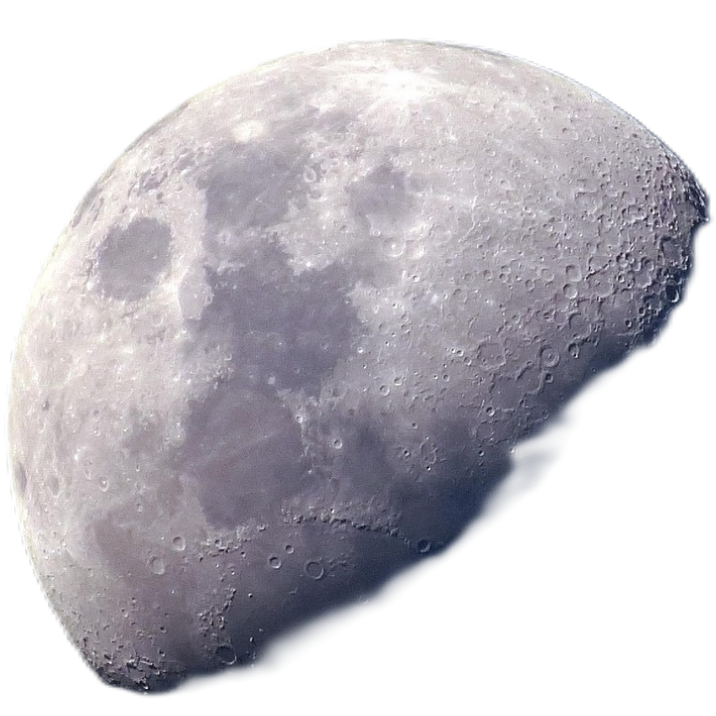
432 AND ABOVE EME NEWS
JANUARY 2025
Volume 54 Number 1
Editor: Peter Blair G3LTF
Associate Editor: Matěj Petrzilka OK1TEH
Production Assistance: Frank NC1I & Bob W1QA
NEWS, CONTESTS and DXpeditions
DL7APV EME Calendar
We are delighted that Zdenek OK1DFC has joined our team to continue the DL7APV EME calendar as Bernd wished. Dates of all things related to EME operation, contests, seminars and contests, or even expeditions, should be sent to Zdenek directly at
https://eme.radio/dl7apv-eme-calendar
EME-2026 Tenerife
You will find the latest information on the conference below. It would be immensely helpful to Rainer if he could get a good estimate as soon as possible of the number of attendees, as this will greatly help with his planning process and negotiations with facilities in Tenerife.
QSY to 1298 MHz
In December Dick PA2DW posted a questionnaire about this on the reflectors in order to gather views and information. He reports below on the findings. Thanks for your time and your work Dick.
EME SSB operation
Andreas, DJ3JJ has contributed some notes, below, on how to maximise the readability of your ssb signal.
Contests
The 2025 contest season starts on Saturday, February 8th with the DUBUS-REF CW/SSB 70cm contest, the DL7APV memorial. Rules and dates for the full series which covers all bands from 432MHz to 24GHz are at http://www.marsport.org.uk/dubus/EMEContest2025.pdf
On 432MHz anyone with a reasonable 4x long yagi antenna and 500 W or more can easily make CW QSOs. Jac PA3DZL works single yagi / 1 kW stations with his 4 m dish and rotatable polarization.
The next DUBUS-REF contest is on 13 cm on Saturday March 8th. 2.3GHz is probably the optimum frequency for EME operation and certainly the best for SSB. The ability to work cross band is very useful. Please read rule 3.6 above which is designed to help with this.
Jan PA0PLY proposes that following the contest on March 8th the activity is extended to add March 9th for digimodes as well. This is independent from the DUBUS contest. There are no restrictions for March 9th so one can make skeds on the HB9Q logger. More about this next month.
2024 13 cm Funtest Results
As I explained in this month’s call for contributions we are unable to access the reports for this event. Only a few stations re-submitted, although there were at least 17 active, and the top score of those was PI9CAM with a total of 25,600 points. SV3AAF had 3200 and PA0PLY 400. We will announce dates for the 2025 funtests next month.
DXpeditions
There is nothing planned until HD8G in mid-April.
https://hd8g.com
The TX7MAS DXpedition had a number of problems covered in the reports below but I understand they had 18 QSOs, the smallest station being a 4 m dish.
DL1VPL Thomas
Have been busy on 70 cm working some new initials:
DC1RDB (easy now with 2x5 WL and 450 W), G0JDL (2x14el. 200 W), R6CS (6x23el. KW, KN95BW), DF6LH (4x14el. 60 W!), KF8MY (2x33el. 600 W EN84CB), F2CT (8x14el. 1,5 kW), F6DRO (2x21el. no Elevation 600 W, JN03TJ).
When I look at some of my QSOs with weak Stations, then I can be quite satisfied with my small antenna, (4x13 elements) in particular after an improvement in fall of 2024. Sun noise here is abt. 8,6 dB (SFU 49) and own echos on good days to -17 dB.
Thomas's SFU of 49 is the 432 MHz figure obtained from an on-line extrapolation - Ed
F2CT Guy
Guy worked on 432 MHz in January DL1VPL ON7EQ HB9Q EA5CJ SM3LBN OH3AWW W4YTB N1AV NC1I OM4EX OE3JPC DK0TE and heard YO2NAA and BD8AIS.
G0JDL John
This is my first contribution to the newsletter as I have only been on 70 cm EME since November 2024. I have limited amount of garden space to work with so I have built a simple system consisting of an Icom IC-9700, 2x14 el YU1CF antennas and an SSB-Electronic SP70 preamp. The antennas are mounted on a bicycle repair stand and I track the moon manually at present by using an old Android phone attached to the antenna crossbeam which is mirrored to my computer and this allows me to keep a check on my moon alignment from the shack using an app which measures both direction and elevation.
My first QSO, like so many other people, was with Frank NC1I just using the IC-9700 with around 60 W at the antenna. I worked a further four initials just using 60 W but at the end of November I bought a secondhand Gemini 70 amplifier and after adding some extra cooling (a rather noisy 120 mm fan attached to the rear of the amp) I now have around 160-180 W at the antenna feed.
Initials worked since mid-November are: NC1I, UA3PTW, PA3DZL, HB9Q, OK1VUM, OZ9AAR, GD0TEP, PA2V, OE3JPC, DL1VPL, DL8DAU, ON7EQ, W5ZN, DL5FN, DL4ZAG. That’s 15 initials and for a little over 2 months on EME it’s definitely more than I expected with such a small system.
I’m really pleased with the results so far and even after holding a license for 37 years I have to admit that nothing has ever quite matched the feeling of completing my first EME QSO. Several fellow EME enthusiast have given me lots of help and useful advice especially Nic, G3YEG and Carsten, OZ9AAR, with whom I had a QSO on three consecutive nights in December just to prove that the first one wasn’t a fluke.
The options for upgrading my system are fairly limited but I hope to add an az/el rotator in the future and I could probably make a useful improvement by upgrading from Ecoflex 10 cable but for now I’ll just enjoy working stations with what I have.
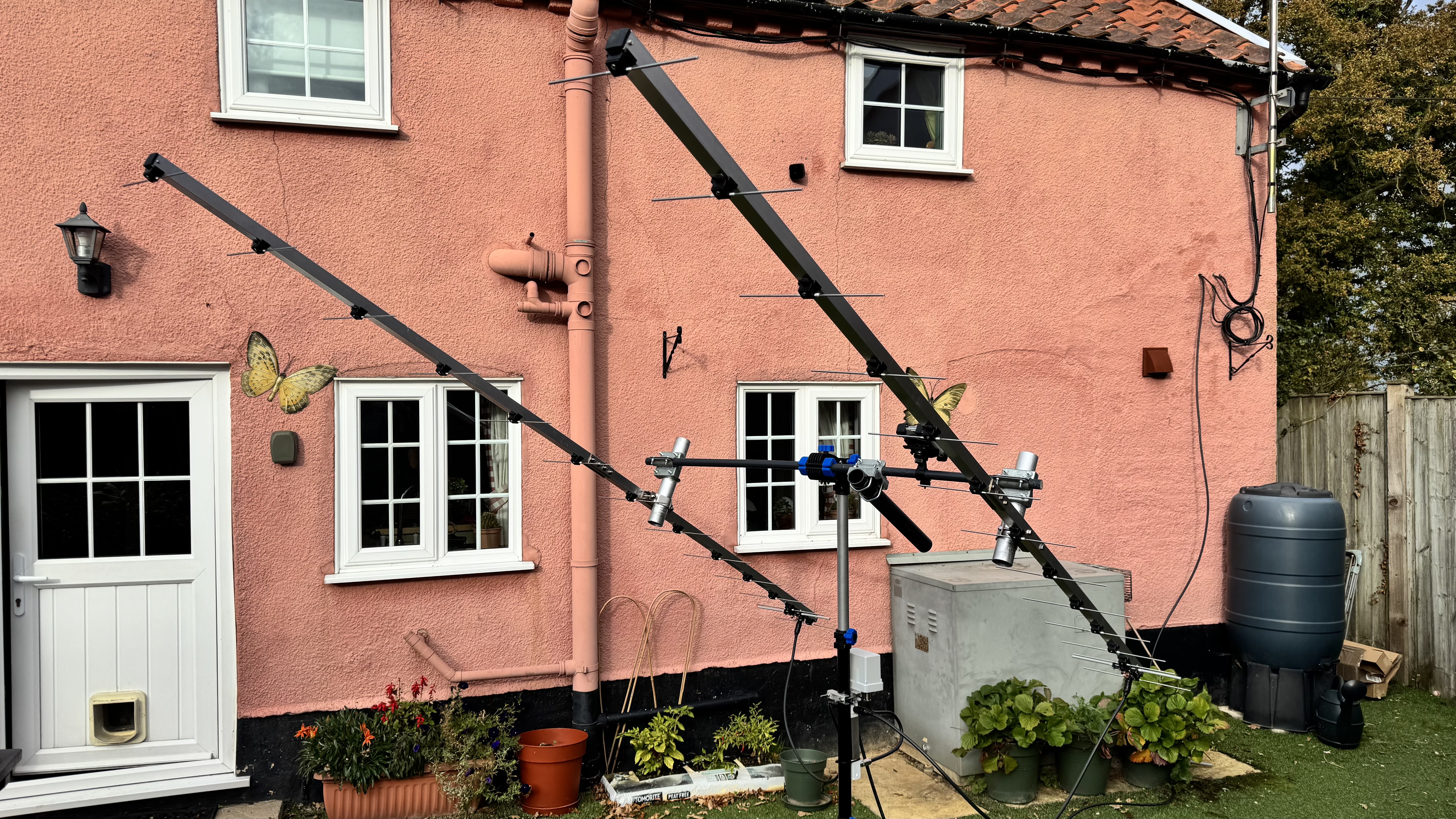 G0JDL antenna
G0JDL antenna
G3LTF Peter
With the continuing calm weather I put the 23 cm feed in the dish and on 9th January worked on CW, G4YTL, N5TM, DL1AT and PA3EXV #553. On 10th I worked CT1FFU #554, OK2PE, IK3COJ, IZ8GGF #555, and K1WHS #556 and on 11th I worked OK1USW #557 3.4m/100W. On 12th I worked OK1VUM, OZ6OL and DF3RU. I injured my right shoulder and so could not wind the dish up high enough to get round to moon-set so I didn't get to look for TX7MAS, but I don't think there was any CW operation from them anyway.
I hope to be QRV for the DUBUS 70cm CW contest.
On the 11th or 12th I was called by a very weak station at a workable level but sadly they gave up after only a few tries. Us OT CW people are very patient; we grew up on 30-minute skeds with 2.5 min periods! Always give a long call, 2 minutes or more, in reply to a QRZ if you are a small station. It takes time to get a weak station, often off frequency but visible on the SDR, tuned in with the IRT and really optimised in the filters. I’m always happy to work CW with small stations, I can normally work anyone with an efficient 2 m dish and 100-150 W.
G4KLX Jonathan
I replaced my linear feed with a Septum feed in time for the moon being usable again for me in December, I also increased my power from 150 W to 200 W in December, and then to 300 W in January since I no longer had a coax relay in the transmit line. The new feed is held up by fibreglass arms and rope, and I ensured that none of the metalwork used was near a multiple of a quarter wave in length. Although it moves a little in the wind, it seems to be ok so far but I probably won't risk it in windy weather.
Activity was relatively low in December, but I still bagged a fair few initials: UA9FA (#66), SM5DGX (#67), LU8ENU (#68), RJ3DC (#69), IK5VLS (#70), OK1USW (#71), CT1WO (#72), OK1IL (#73), K1WHS (#74), DF2VJ (#75), SP7EXY (#76), JS6UJS (#77), RA9FLW (#78), DJ7FJ (#79), IZ8GGF (#80), ON4MU (#81), and OZ6OL (#82).
January was busier and I was able to break the 100 initials barrier during the month: OE3JPC (#83), KD5FZX (#84), 9H1BN (#85), W1FKF (#86), G0HIK (#87), UA9YLU (#88), DK3WG (#89), GM4PMK (#90), M0FXX (#91), PA3JRK (#92), W2LPL (#93), (#94), KB7Q (#95), EA1IW (#96), DL1HUH (#97), CT1FFU (#98), YO2LAM (#99), F5KUG (#100), K3SK (#101), N0CTR (#102), RD9SAC (#103), CT2GUR (#104), RN6MA (#105), IZ4VSS (#106), OK1VUM (#107), OH2DG (#108), and PE1LWT (#109)
In December I heard DL0SHF strongly on CW but found that I couldn't reply due to issues with the driver radio, however I think it would have been an easy QSO if I had been able to get any RF out.
At the behest of G0LBK I got QMAP running using an RF splitter and an AirSpy SDR and although it doesn't have the same sensitivity as the full blown WSJT-X program, I think it is 1 to 2 dB less sensitive, it was still very useful and enabled me to make a few new initials. I'm currently running the latest RC version of WSJT-X which I find to be very reliable compared to earlier editions and bodes well for the final released version.
I find it pleasing that direct QSLs are still a thing on EME. It has forced me to get some printed with the picture of my dish which was published in a previous newsletter being on the front. Once I receive them from the printer, I'll reply to all those who have sent me QSL cards to date.
I wrote a quick program that I've named MoonList which does moon predictions in the form of static web pages so you don't have to run a program every time to see where the moon is at your location. What makes it different to other such programs is that you can provide it with information about your home location so that it can take into account local obstacles and therefore can provide accurate visibility information. This has proved very useful in my hemmed-in location. It's a pretty basic program but it makes my life easier. It builds on both Windows and Linux and can be found on the g4klx GitHub page with the name MoonList: g4klx/MoonList: Run monthly moon predictions with site restrictions and preferences.
I have now worked enough people twice or more to be able to compare my received signals going from linear to circular polarisation, and also from my original noisy pre-amplifier to a much better WD5AGO one. The move from linear to circular polarisation and the improvement in pre-amplifier and the removal of the coax relay provided an average of 4.4 dB improvement based on nine comparisons. The move from linear to circular polarisation but with all else being the same except the coax relay in circuit gave an average of 2.5 dB improvement based on eleven comparisons. There were one or two anomalies which makes me wonder if there were changes at the far end also.
KB2SA Bill
TX7MAS - in summary, they had great TX and poor RX (yagis with no LNA) for the first 2 days. Then they had both poor RX and poor TX for the remaining days. They apparently replaced their LNA, but I didn't observe an improvement in their RX. I think there were other factors that affected their performance (e.g., moon tracking errors, weather, operator error and/or connection losses). Verified signal reports from TX7MAS:
| CALL | TX7 REPORT | DISH | POWER |
|---|---|---|---|
| ON4AOI | -26 | 4.5 m | 200 W |
| DL4DTU | -25 | 4.6 m | 750 W |
| OK2DL | -28 | 6.0 m | 1000 W |
| NC1I | -21 | 6.1 m | 500 W |
| OK1KIR | -20 | 6.1 m | 1000 W |
| SM5DGX | -20 | 8.0 m | ? W |
| OK1DFC | -27 | 8.0 m | 600 W |
| DG5CST | -26 | 10.0 m | 300 W |
| HB9Q | -16 | 10.0 m | 1000 W |
KB7Q Gene
Winter finally arrived here in Montana (DN45) and made up for lost time with a string of snowstorms. January 7/8 finally saw a lovely open patch of weather with bright sun, no wind, and blue skies. I shoveled a path from the barn to the antenna mount, mounted the dish and had two nice EME sessions on 23cm. Worked were PA3EXV, IZ8GGF, AA5C, W2HRO, GM4PMK, CT1WO, DL1AT, OK1AT, W2LPL, K1WHS, G4KLX, M0FXX, SP7EXY, KB2SA, and N5TM.
Five of those stations were new to me, so my 23cm initial total stands at 186 stations. Not bad for a 2.4 m folding dish with 400 watts at the feed.
Windows 11 started an update in the middle of the second session that lead to 15 minutes of chaos, but alls well that ends well. I usually check for updates before each operating session, but not this time apparently.
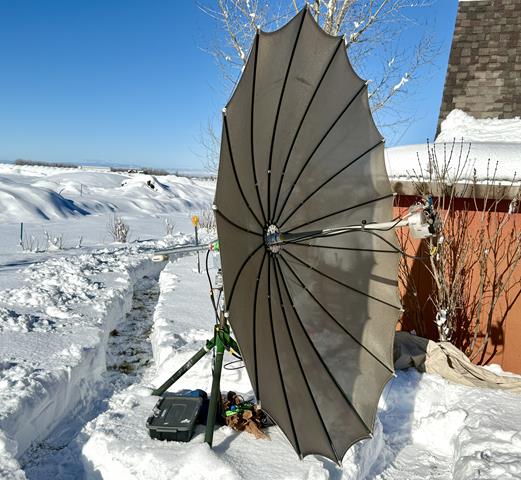 KB7Q dish in the snow
KB7Q dish in the snow
NC1I Frank
Initials worked on 70cm in January include SK6EI, OK1IN, BD8AIS, F2CT (big signal), and LU7MC. On 23 cm the following initials were added; R6CS, DL8EBL, and TX7MAS for a new DXCC. I would like to thank the TX7MAS group for their efforts, I know they had many challenges but they did their best to work as many stations as possible. Activity on both 70 cm & 23 cm seemed low in January. Hopefully activity picks up in the coming months.
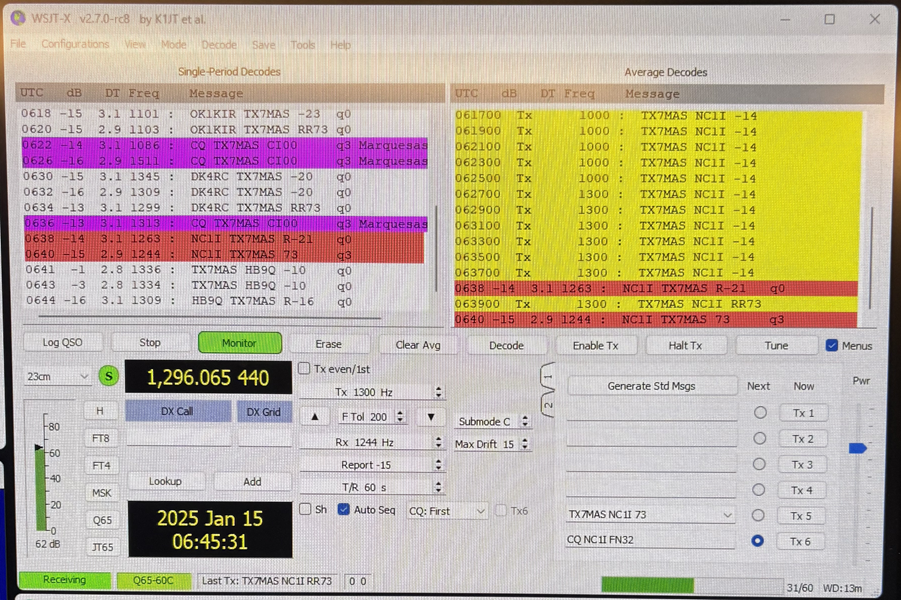 NC1I TX7MAS WSJT QSO
NC1I TX7MAS WSJT QSO
OK1DFC Zdenek
I am sending my contribution to NL01/2025. First let me wish you good health and happiness for 2025. I was not QRV during the end of December 2024, so there is nothing to write about. In January I was concentrating on the TX7MAS expedition which was to be a QRV from the new DXCC country. Based on the description of their equipment on the expedition's website, I assumed ease of operation and the ability to work both Q65 and CW. Unfortunately, the opposite was true. The weather was bad here in OK, and I didn't want to get up early in the morning and figured I'd wait until the QRVs were fixed. I watched HB9Q for the first two unsuccessful days when even Dan HB9Q with his equipment was unable to make contact. On the third day the problems were fixed and TX7MAS made the first few contacts. So, I decided to go on the air the next morning as well. I was ready from moonrise in TX7 and established a contact with them after the signal appeared. TX7MAS is #137 DXCC for me on the 23 cm band.
I spent more time developing and producing a new version of the septum feed for the dishes supplied by W2HRO. I chose a version with a tilted baffle based on the original version in the IEEE to simplify production. I am sending a picture of the drawing and some photos. RX and TX port have SWR better than -30 dB and the product is made of 1 mm thick aluminum sheet, welded construction using laser welding head. The total weight including the bracket made on a 3D printer from plastic is 980 g. I am sending this feed to Alex EA8DBM for testing. I am also working on a version for 13 cm. That should hopefully be ready next month as well. I hope that this feed will prove to be a good one and will make the work easier for all who use these nice dishes. The main saving is again the power coax relay and interconnecting cables. The isolation between RX and TX is -24 dB. Only a small SMA isolation relay on the RX port will be sufficient to protect the LNA from destruction.
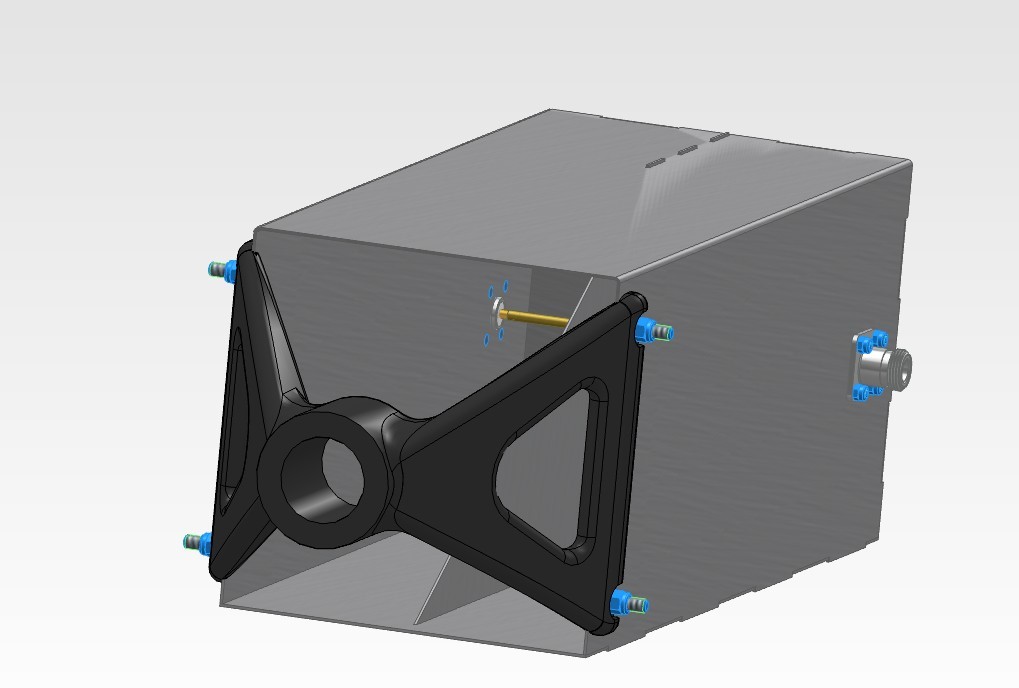 OK1DFC 23 cm feed light
OK1DFC 23 cm feed light
 OK1DFC septum feed 23cm light
OK1DFC septum feed 23cm light
 OK1DFC 23cm feed components
OK1DFC 23cm feed components
 OK1DFC 23cm feed side view
OK1DFC 23cm feed side view
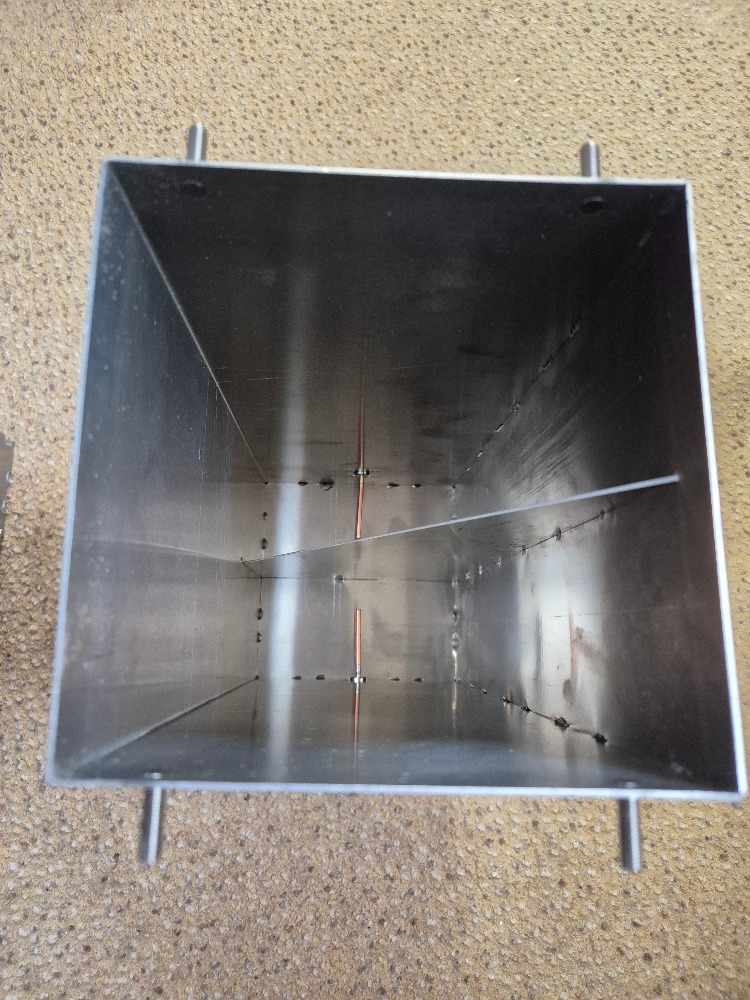 OK1DFC 23cm feed end view
OK1DFC 23cm feed end view
OK1KIR Vlada
For 23 cm TX7MAS expedition on Marquesas Isl. with the pair of 70 el. loop Yagis we installed in advance a rotatable linear feed to eliminate 3 dB loss of the otherwise ordinary used septum CP feed. On Jan 11 eve we made with Q65-60C QSOs with IZ8GGF, IZ4VSS, W1FKF, DL1HUH as new initials #608…#611.
Early morning on Jan 12 TX7MAS appeared with great signal (B-13) but unable to find a signal neither decode it. Next day, Jan 13 situation unchanged, so just wasted time. On Jan 14 situation same as on Jan12, i.e. great signal, unable to decode.
On Jan 15 after removing VLNA and receiving directly only with IC9700 they finally found and decoded signals and completed first QSOs but only with big guns.
We succeeded at 06:21 with Q65-60C (-14 dB/-23 dB) as first TX7-OK QSO on 23 cm, initial #612, new DXCC #137 and new field CI. Dpol at the QSO matched the prediction.
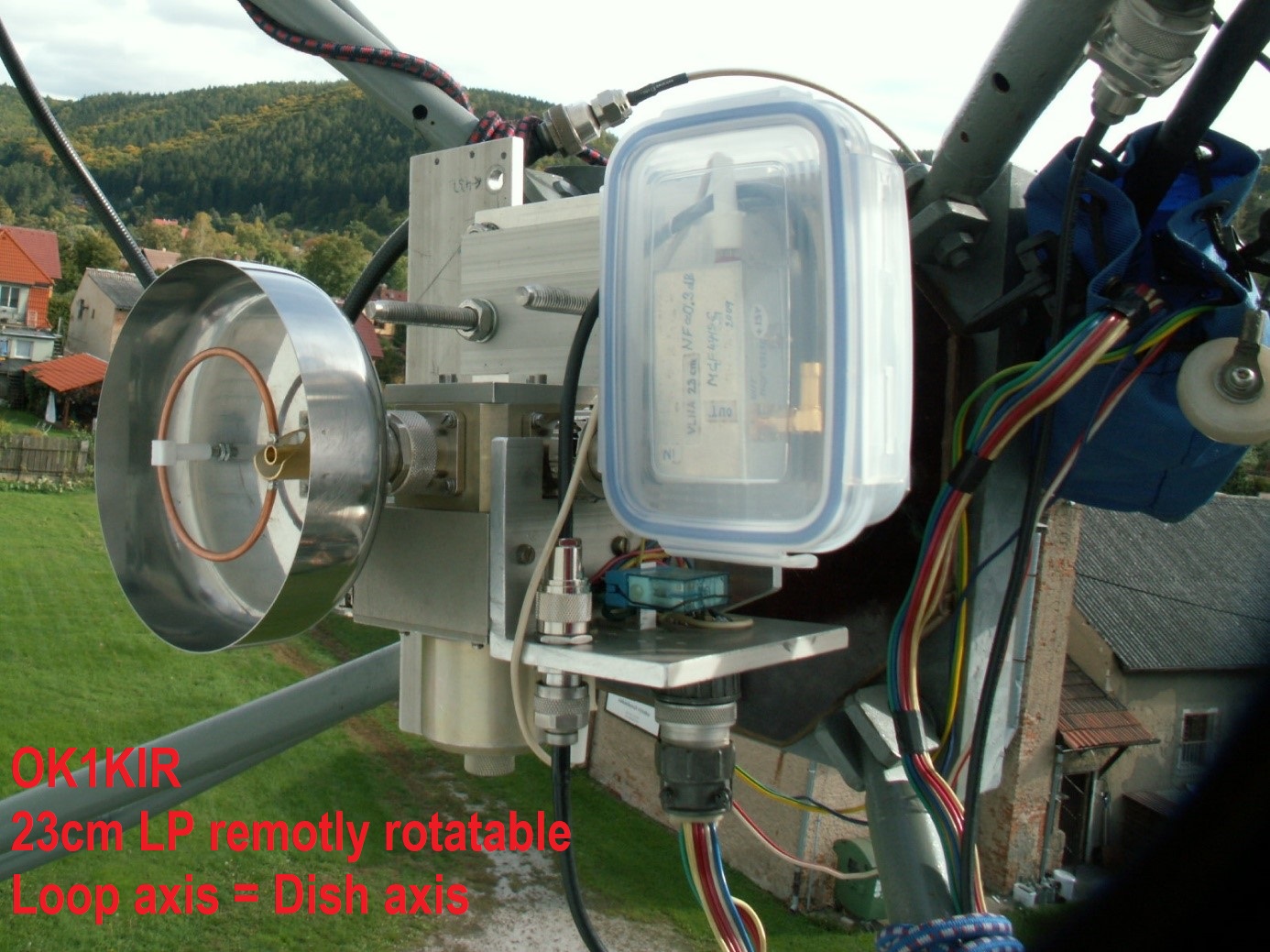 OK1KIR 23 cm remotely rotatable LP feed
OK1KIR 23 cm remotely rotatable LP feed
ON4AOI OT7K Guy
After getting WAS #12 in 2022 on 23 cm and WAS #36 in 2023 on 70 cm thanks to the efforts of KA6U and KB7Q and in 2024 I got DXCC #13 on 23cm, I have received my 23 cm DXCC! All my standings after 44 years being active can be seen on QRZ.COM or https://www.on4aoi.be
It sure was thrill to achieve this Award but to be honest It would have taken many more years if I and many others didn’t have Alex EA8DBM aka LY3UM who provided us 17 dxcc (I didn’t work him in EA9 since I had worked Zdenek before there) in the last 2 years. Alex will do some more trips in 2025 so keep watching out.
TX7MAS - I started to monitor @ their moonrise on Sunday the 12th and decoded them at between -20dB and -21dB, considering the difference in polarization and the used power in FO/m it looked promising, until I saw stations with +6 M dish and High power getting no reply. When asked them on HB9Q logger they answered that they did not see any trace? This was the same problem on Monday and Tuesday, I gave them the advice to remove the preamp since it was not normal that I saw callers at +3 dB and they didn’t have any trace. In the meantime I posted some screenshots on HB9Q – chatpage with wsjt-x settings and to make some marks on their setup from the SUN, when available, so they could align AZ at a known point, also how to set the radio (AGC-OFF, preamp in IC-9700 ON etc).
On Wednesday MR they had removed the preamp and probably did some of my suggestions since when I started to RX them they were -15 dB even audible in the speaker. That was looking promising until I saw them reporting DG5CST with a 10 M dish -26 dB…… After they worked 6 big stations and they always changed their TX on the DF of the caller, there were no more callers.
I asked them to try Q65-120D and to put my callsign in, if they did do that is unknown but they agreed to try Q65-120D. After a few loooooooong periods on their LAST DF I nearly fell out of my chair when they replied to me and we could complete 4 min later. Could the magic be Ground Gain since my EL was below 10 deg or just huge luck? One thing I know 100% sure is that moon AZ was pointing over a 200 m long x 100 m wide concrete 0.50 m thick floor with double iron network. I had this phenomenon also with EA8DBM on one of his visited countries, I decoded him less than normal but he didn’t see me until I was nearly at the same Azimuth direction as TX7MAS.
Dual band 23/70cm feed - In the meantime I started to build a new setup to add 4 x 4 elem for 70 cm in front of my dish without removing the 23 cm septum. I started already with a small document that can be downloaded here below: https://www.on4aoi.be/Adding%2070cm%20H-V%20to%20my%2015ft%20dish%20with%20Septum.pdf
I will update this frequently to have a complete document with all drawings etc. Weather won't permit me to do this before end of March anyway 😊
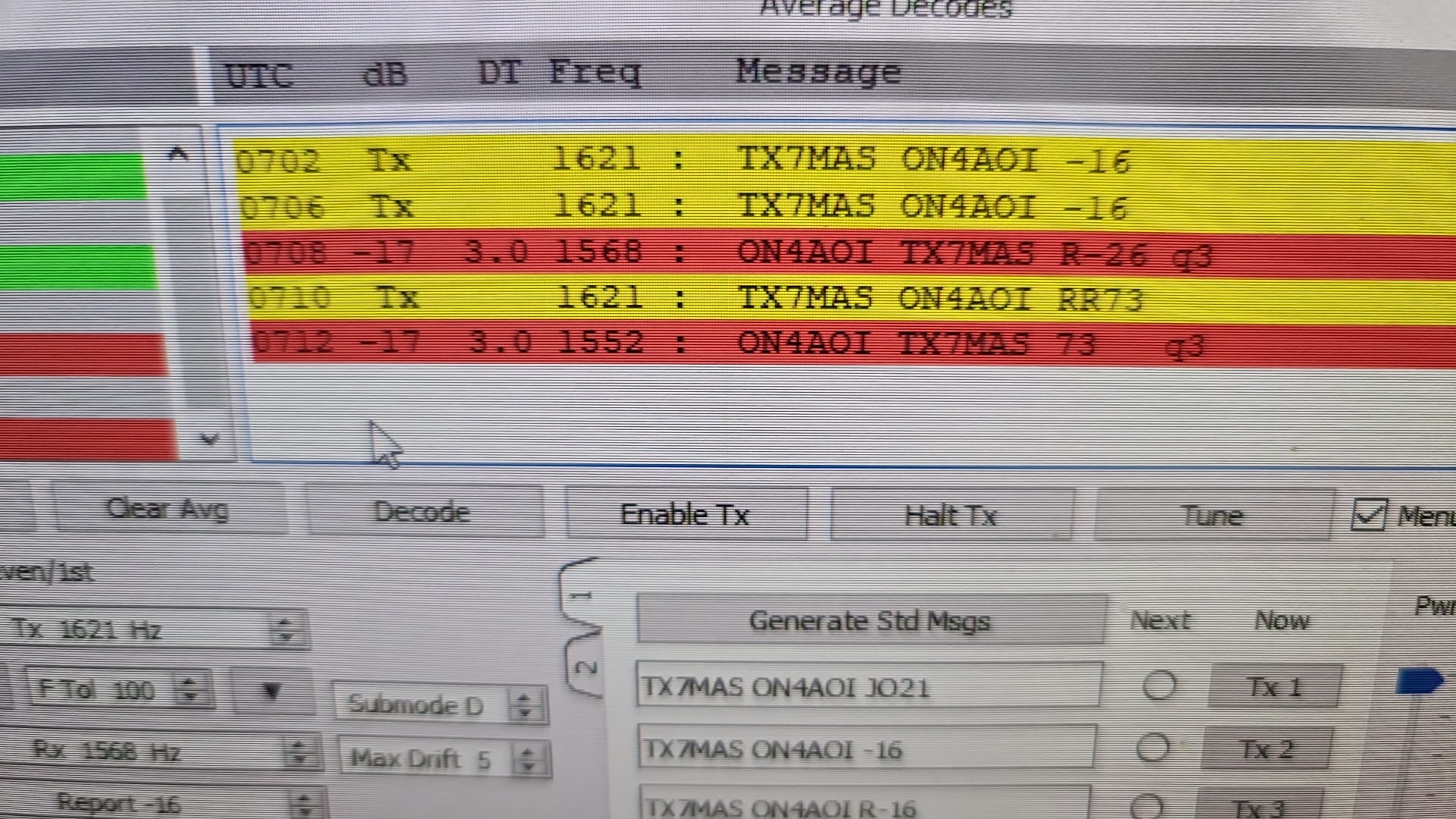 ON4AOI TX7MAS WSJT QSO
ON4AOI TX7MAS WSJT QSO
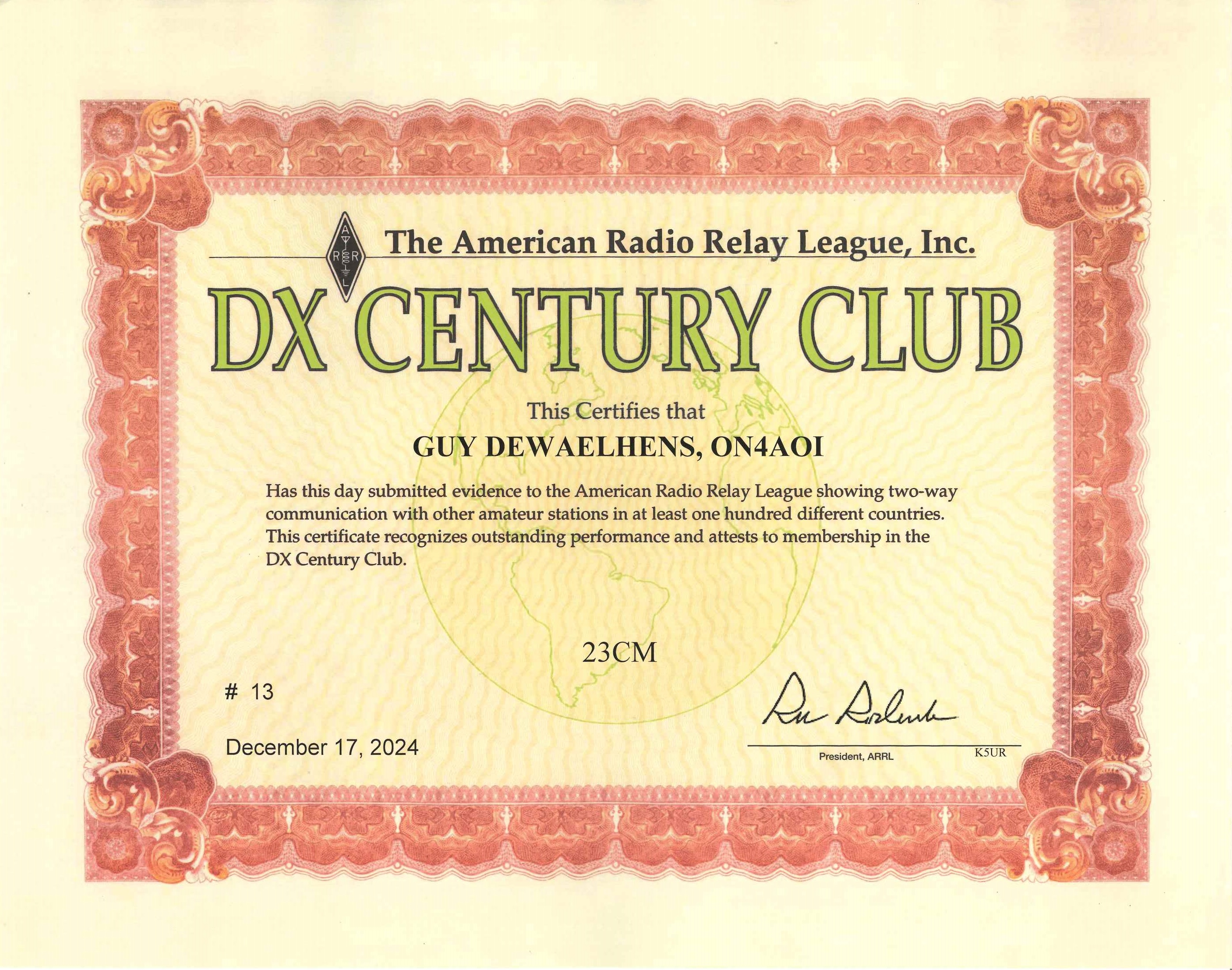 ON4AOI 23 cm DXCC number 13
ON4AOI 23 cm DXCC number 13
PA3DZL Jac
Jac reports on his multiband activity in the period 4th to 19th January:
Worked on 432 MHz all in Q65B-mode:
YO2NAA, DC1RDB, IZ6MVK, DF6LH #initial, GØJDL, NY1V, ON7EQ, W4YTB, N6WS and W5ZN
Worked on 1296 MHz in Q65-60C or Q65-30B mode:
YO5TP, GM4PMK, DF7KB, IZ8GGF, G4KLX, CT1WO, ON4BCV, NY1V, PHØV, MØFXX
And a very nice NEW DXCC TX7MAS from Marquesas Is, was very pleased to QSO on Thursday the 16th, I was already looking for TX7MAS from Sunday the 12th. It was not easy but great to do when it works!!
Was also very pleased to QSO with Richard, NY1V on 144 MHz also for our 3rd band after 432 and 1296 Mhz. I made 18 EME QSOs on 144 MHz during this period.
Worked on 10368MHz in Q65D mode:
G4YTL and CT2GUR
VE4MA Barry
Since my last report it has been a little quieter operating wise. The weather has been very cold with regular very high wind and snow events. The present temperature with wind effect is -44C. I have kept the 3cm system and 33 cm in the dishes and have done a small amount of operating on 3cm. I have continued to work on station improvements to the 70 cm and 47GHz systems.
On January 10th on 3cm I did QSO W2HRO, DG5CST, and KM0T. On January 11 the DL0SHF 10 GHz beacon was -1 to -2 here and I QSO’d OH3LWP ( -7, -12).
On January 16 I was QRV to test again with KL6M on 3 cm CW. Mike was “O” copy briefly but we did not complete. Apparently Mike was cross polarized. He had been experimenting with different feedhorns to under-Illuminate his 30 ft dish and I think he should be good on the next moon cycle. I also worked I6PYK again easily and ON5TA.
VK2CMP Mick
I have been on holidays and have not had too much activity over the last two months. We also have had storms for over a week which also resulted in some falling branches bending a few elements on the 432 array. Fortunately the YU1CF element are stainless steel and bend back very easily.
I did manage one new initial YO2NAA and Ady’s working conditions are a single yagi and 200 W which is always fun to work.
I have been playing with TotalPower V8s new feature for Noise Horizon plots which now provides On-the-fly mode for the rotators as well as Step-by-Step modes. On-the-fly uses a continuous movement and measurement of the rotators/ array and is very fast compared to step-by-step measurements.
W2LPL Les
After being highly motivated by the Trenton EME Conference, I have made numerous incremental improvements to my 1296 station and 2.3 m Sub-Lunar Hex dish including improving the focus, tracking and changing to a higher power amplifier (from 200 to 400 W, at the dish) and improving NF before the Preamp.
I have modified my AlphaSpid RAS setup to utilize a low cost Mems inclinometer by Level Developments and no longer use pulse counting for EL. Its been accurate for months. There were some minor issues with the feed, and the focus which have been ironed out. I had in the past been struggling to work smaller stations but since these changes I have been able to work UA9FA and IU4MES with their 1.8 M dishes as well as folks with 2.4 M and smaller like KG0D, W2FKF, G4KLX, KB7Q, AB6A, CT2GUR and PA3JRK. The improvements will continue and I am excited by the various projects out there to develop a light weight, lower profile Septum for the Sub-Lunar dishes.
Optimising Your EME SSB Readability
by DF3JJ and G3LTF
G3LTF spoke recently to Andreas DJ3JJ on the QO-100 satellite about SSB readability on EME and the big variability there seems to be between stations. Here are Andreas’s thoughts on how to optimise readability. He plans to run an “ssb appetizer” contest again this year and details will be in a later newsletter.
- Take a QSO partner on terrestrial for readability test.
- Set your Mic gain between 50% and 70%, depending on how close you are speaking into your Microphone.
- Reduce your tx power or turn antenna, until your partner is copying you max. S1.
- Speak to your Microphone from the side NOT from the front, because of Air Noise.
- Check for your readability at this Signal level.
- Without Speech Processor the average Power level should be 50%.
- Activate the Speech Processor inside your Transceiver and run it at 70%.
- Check with your QSO Partner the improvement in readability.
- Use the TX Equaliser function of your Transceiver if it has one.
- Use about 300 Hz to 2.400 Hz with a boost for the higher frequencies.
- Do some experiments with different Microphones.
- Ask your qso partner to make a recording of your readability at beginning and end of test.
If you listen to this audio file, you can check for yourself, if you are satisfied with the result.
G3LTF comment:
I adjusted my ssb for eme operation by listening to my echoes and adjusting the tx bandwidth, equaliser settings and compression on my TS590 for best readability. (TS590 is my IF transceiver at 14MHz). I also looked at the received spectrum on the SDR which was very instructive.
1298 QSY
Responses to the questionairre by PA2DW
On 29th December last year, I posted a questionaire on both EME-reflectors. There were not that many reactions, which could mean that most involved EME-ers agreed with the proposed way to go forward.
An overview of the questions and reactions:
Question 1. There will be technical consequences when moving up to 1298-1300 and we would like to know all possibilities and limitations. Most of our current equipment will work flawlessly in the new bandplan. But if not, then we think Moon-net is the place to share technical information and help to each other. So please share your thoughts and solutions with us regarding consequences for any part of your station (Radio, PA, LNA etc.) that might need adaption.
Reactions:
- Only one station reported that moving up in frequency would involve a lot of work/modifications. Especially Yagi’s that were tweaked for optimum result on 1296 are that narrowband, that the performance on 1298 is highly affected. Owners of dishes reported that the bandwidth of their feed easily allows moving 2 MHz upwards.
- All users with modern transceivers working directly on 23cm, such as TS2000 and IC9700, reported to have no problem with moving 2 MHz up.
- Users with transverters will need to exchange the LO X-tals.
- Some of us have an HF-rig as IF. At least the widely used Elecraft K3 works above 30 MHz in “transverter mode”, but with slightly less performance. A fix is to modify the Low-pass filter by exchanging some capacitors. An easy to perform modification is being prepared.
Question 2. There are regulatory or environmental limits to operate in the 1298-1300 range in some regions. We know that Italy is one of them and Malta suffers radar above 1300 MHz, but is there more that we don’t know yet?
Reactions:
- Italy reports good progress in their negotiations to expand their allowance up to 1300 MHz, but it is not yet finalised.
Question 3. Other authorities have been very speedy in allowing the QRO/EME operations only to above 1298, like Finland. But what is the current situation in your own region? And do you know if there are negotiations being planned/executed with the authorities?
Reactions:
- No other country than Finland has reported these steps by their authorities.
- Some reported however, that their local authorities have recently been putting the issue on the agenda for future negotiations.
Question 4. Some authorities have been limiting the power even well in advance to the outcome of WRC23, like Austria. Others still agree on 750 W or even more. In Holland we are facing a very stable limit of 120 W since many years ago… But what is the situation in your region?
Reactions:
- Nobody reported changes
Question 5. And finally, is there any reason not to identify 1298.000-1298.150 in the band plan as a “centre of moonbounce activity” otherwise what would you prefer, above 1298?
- Generaly almost everyone agreed with moving up to 1298.000-1298.150
- A few mentioned that moving up to 1299.000-1299.150 brings us even further to the edge of the Galileo-spectrum and would show our goodwill / preparedness to the primary users to solve the issue
The next step in this process is that we will report the above information within the IARU. In Region 1, is has been put on the agenda on the interim meeting in Paris, April 2025
Thanks for all reactions/feedback!
Dick PA2DW
It would be useful to hear people's experiences of running SSPAs on 1298MHz into the feed, as opposed to a 50R load - Ed
EME Conference 2026 Tenerife
The EME Conference 2026 takes place in the Hotel Botánico & The Oriental Spa Garden
Date: May 28th-31st, 2026
Unfortunately many of the local hotels don't have the capacity or just are not interested in groups for a weekend. But finally after very long and hard negotiations we were able to agree on prices with the Hotel Botánico & The Oriental Spa Garden.
Special prices are:
- Single room: €225/night
- Double room: €255/night
Rooms with sea view have a supplement of €12 and superior rooms have a supplement of €70 for the superior Teide and €90 for superior sea view.
The booking must be made by January 31st, 2026 at the latest using the code "EME2026".
These prices also apply if you arrive a few days before the conference begins and/or depart a few days after the conference.
Hotel Botánico & The Oriental Spa Garden
Avda. Richard J. Yeoward,1
38400 Puerto de la Cruz
Tenerife - Spain
T: (+34) 922 381 400
F: (+34) 922 383 993
https://www.hotelbotanico.com
Registration:
The registration fee for participants will include:
- Conference Room rental
- Morning coffee break
- Business lunch Chef selection course
- Afternoon coffee break
- Saturday night dinner
Estimated price €400,-
Registration fee for spouses t.b.a. later
Please pre-register now at
http://eme2026.moonbounce.info/register.html
73, Rainer EA8DMF
http://ea8dmf.vhf-dx.net/
WANTED
W7TXT James
Looking to buy a 47 GHz PA and a 47 GHz LNA.
morrisjl {AT} gmail.com
DUBUS-REF CW/SSB Contest 2025
70 cm SAT Feb 8 (24h) DL7APV Memorial
13 cm SAT March 8 (24h)
23 cm SAT+SUN Apr 5+6 (48h) VK3UM Memorial
9 cm SAT May 3 (24h)
1.2 cm SAT June 21 (24h)
3 cm SUN Jun 22 (24h) K2UYH Memorial
6 cm SAT Jul 19 (24h)
CW Initial List
https://www.g4rgk.co.uk/Initials
Sun & Extraterrestrial Noise List
http://www.ok2kkw.com/next/nl_k2uyh/sun_table.xls
DL0SHF Beacons –
DK7LJ
3cm 10368.025 MHz
1.2cm 24048.025 MHz
EME Directory by Jan PA0PLY
https://www.pa0ply.nl/directory.htm
Newsletter Contacts
Peter G3LTF
Matej OK1TEH
Frank NC1I
Bob W1QA
Please send newsletter contributions to Peter G3LTF